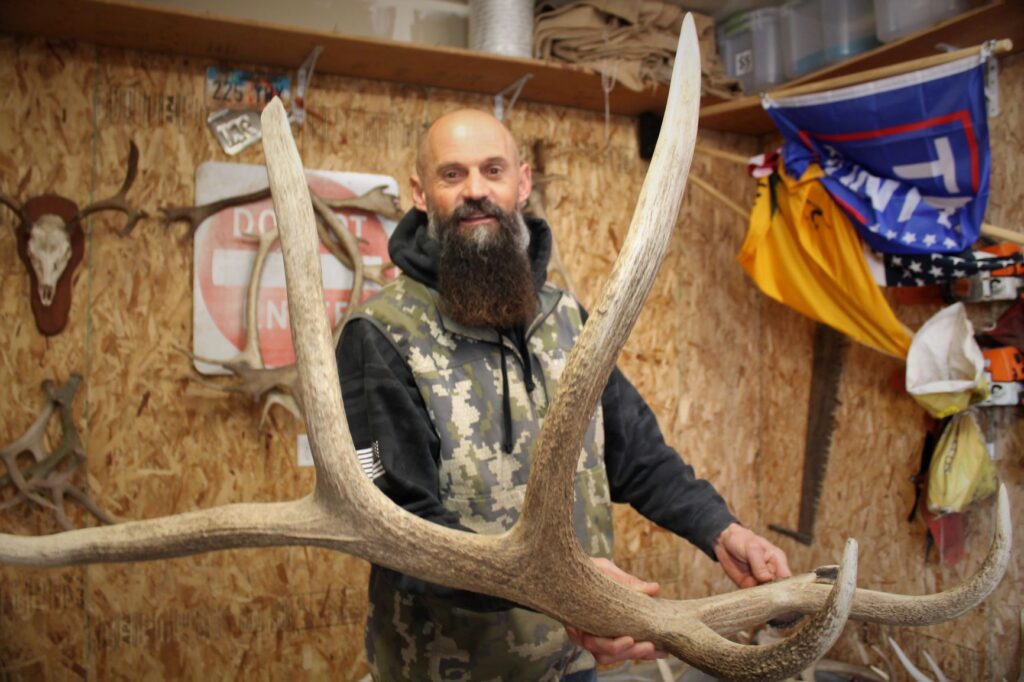Steve Sorensen holds an elk antler in his collection. He buys and sells antlers from all over Utah.
HYRUM – Antler hunting from deer, elk and moose sheds are becoming a popular pastime for people these days, said Steve Sorensen, one of two antler brokers in Cache Valley.

Sorensen is from Hyrum and just sold a load of antlers.
“There are more and more shed hunters now days,” he said. “There are also a lot of buyers and the margins are getting tighter.”
Sorensen said there is only about a 10-percent margin compared to what it was when he first started 23 years ago when he was a kid.
“Finding them is a real rush,” he said. “I take my kids, it gets them out of the house, away from video games and up in the mountains. It’s an adventure.”
The avid hunter said he enjoys seeing new country and he will go all over the state to find sheds.
“It’s a good hobby that will pay for itself if you are good at the game,” he said. “You have to time it just right because there are more people out there trying to pick them up than ever.”
Sorensen works with an organization Hunts for the Brave. He takes veterans to collect sheds, sells them, and donates the money back into the program.

“We take the veterans on some private land,” he said. “A land-owner saves a spot we can go and pick up antlers.”
The organization takes the veterans hunting during the different seasons for game animals, too.
“The veterans are a bunch of good guys,” Sorensen said. “They have sacrificed a lot so we can live free.”
He said it is too early to go out and hunt for antlers right now. The animals are still going through winter, and putting pressure on them hunting sheds can put them at risk.
“There are some people snowshoeing around big game this time of year and that puts pressure on the animals up there in the snow,” he said. “It is pretty rough on them. I don’t do it this time of year, it’s too early.”
In Utah, shed hunters are required to take a course on the ethics of shed hunting.
Before families and individuals head outdoors to collect shed antlers, please remember that you must complete the Utah Division of Wildlife Resources’ Antler Gathering Ethics Course.
“During winter, big game animals, especially deer, often have a difficult time finding food,” DWR Capt. Wyatt Bubak said. “If you spook an animal and cause it to run, the animal has to use up its fat reserves and the energy it needs to make it through the winter.”
From late winter through early spring, the habitat that big game animals rely on is usually wet and easily damaged. Fortunately, people can gather shed antlers without stressing the animals or damaging their habitat. The free antler gathering ethics course will teach people how to hunt them.

You can find the course on the DWR website. After finishing the course, print the certificate of completion and carry it with you while you’re gathering antlers.
Completing the course is mandatory for gathering shed antlers from now until April 15.
Upon completed the course, a person can gather antlers almost anywhere in Utah, except for the following areas:
- Wildlife management areas: Many of the state’s wildlife management areas are closed in the winter and spring to protect animals and their habitat. Make sure to double check for any closures before entering a WMA to gather shed antlers.
- Private property: You must have written permission from the landowner before gathering antlers on private land. Otherwise, you risk getting a citation.

If hunters should find a skull or dead animal with the antlers or horns still attached, it’s possible the animal was poached. Do not pick up or move the skull or disturb footprints or other evidence at the scene. Instead, please do the following:
- Take photos of the skull from a couple of angles
- Pinpoint the location of the skull (preferably using GPS coordinates)
- Report your find to the nearest DWR office
- Provide specific details in your report
The DWR will send a conservation officer to investigate. If it’s clear the animal died of natural causes, you might be allowed to keep your find.
For more information about gathering shed antlers in Utah, call the nearest DWR office.

